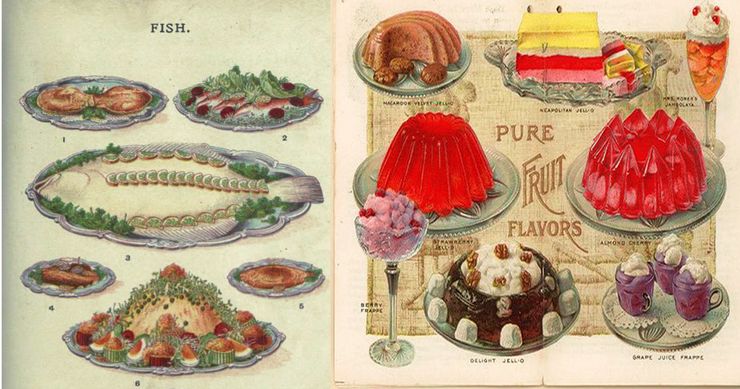Sticking with the general topic we started last week, let’s take a look at some of the foods popular during the Victorian Era.

The Victorian Era lasted from 1837 to 1901, and got its name from the reign of Queen Victoria in the United Kingdom. In the kitchen, many of the foods, recipes, conventions, products, and even meal formats that we use today were invented and popularized during this era.
The invention of the gas stove revolutionized Victorian cooking. A gas stove made it far easier to control the temperature and tweak cooking habits than a wood-burning stove. Another notion that gained popularity during this time was the idea that “a woman’s place is in the kitchen.” Rather than a labor-intensive chore meant for servants and lower-class citizens, cooking became more of an art form that the “little woman” was expected to master. This idea, plus the advancing kitchen technology (whiskers, mechanical peelers, potato mashers, and even a prototype icebox), encouraged Victorian women to become ever more creative, experimental, and complex in their home recipes.
The typical Victorian diet consisted of a lot of fish (meat was still more expensive), local, seasonal fruits and vegetables and greens like onions, turnips, spinach, broccoli, apples, cherries, and parsnips. Nuts were available and popular too. These could be roasted and sold from food carts. Some rare and expensive foods and products (like ice, sugar, and spices) experienced a tax reduction over the century, which brought about the creation of new foods and snacks. Street vendors were making and selling hard candy for the first time.
The Victorians invented the full English breakfast, with eggs, sausages, tomatoes, and baked beans. The two- and three-course meals, invented for the queen, consisted of meals served in batches of soups, roasts, and salads at the end. And there was the ever-famous afternoon tea, usually served with milk and sugar, a rarity that previously only the very rich could afford. Meals became a very important and intricate affair, with people changing clothes for each one.
Some other notable inventions of the period were rolled oats (in particular, Quaker oats), breakfast cereal, ice cream (which led to ice cream soda floats) and, by the end of the century, even hamburgers. Many of the brands we know and eat today were invented in the Victorian era: Amaretti cookie tins, Bell’s poultry seasoning, Coca-Cola and Pepsi both, and Colman’s mustard.
Here are some unusual Victorian foods that were popular then, but not so much now:
- Marrow Toast: Parboil the marrow with a little salt for about a minute. Drain and toss with parsley, salt, pepper, lemon juice, and a smidge of shallot. Spread onto crisp toast triangles.
- Jellied Eels: Boil the eels in a stock with various herbs, then cool so the eels make their own gelatin. Top with a pat of butter or a splash of vinegar.
- Kedgeree: This dish is a smoked haddock, milk, and rice stir-fry, topped with halved or quartered boiled eggs, and seasoned with curry, coriander, and turmeric.
- Brown Windsor Soup: This is composed of beef gravy, malt vinegar, pepper, dark dried fruits like dates or figs, and an optional dash of Madeira wine.
- Boiled Calf’s Head: Start by scraping off the hair and removing the eyeballs and brains, then chop off the ears. Then, boil the head in salted water. While it’s cooking, sauté the brains with salt, pepper, parsley, cayenne, lemon juice, and butter. Serve on a platter around the severed tongue of the calf. The rest of the head is displayed at the center of the table.
- Sheep’s Trotters: boiled or fried (sold by street vendors), these were a popular snack among lower-class citizens because they at least tasted like meat, though there was little substance to them.
- Pickled Oysters: Victorians would pickle seafood to keep them comparatively fresh for weeks or even months.
- Galantine of Turkey: This is cold, boiled turkey with mayonnaise. It calls for a whole, boned turkey stuffed with a sausage and pistachio stuffing, to be wrapped, boiled in stock, and served cold, jellied, and covered in mayonnaise.
- Haggis: One recipe called for the heart, tongue, and a part of the liver of a sheep, with a third of its weight in fat bacon, anchovies, bread crumbs, grated lemon peel, eggs, wine, and salt and pepper. This is stuffed into the stomach of the sheep and cooked like a sausage.
- Saloop: A hot drink made with sassafras bark flour, flavored with milk and sugar.
- Water Souchy: This is a sort of seafood stew, only not as tasty sounding. Throw your fresh catch or fishy leftovers into a pot of water and boil, adding parsley root and wine if you have any.
- Fish Paste: Bloaters (cold-smoked, salted herrings) were popular because cured meat lasted longer, and fish paste lasted even longer than that. Eat it as a paté on toast or as a sandwich filling.
I’m not sure I’d have enjoyed a Victorian feast, but it would have been interesting to watch the show!
